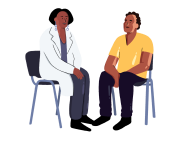Overview
Drinking alcohol is part of UK culture and drinking moderately (within the UK chief medical officers low risk drinking guidelines) doesn’t cause many problems. Approximately 1 in 2 people in the UK have had an alcoholic drink in the last week. This number has steadily decreased since 1998, particularly amongst younger people. Whilst the overall number of people drinking has reduced, the number of people who experience alcohol dependency is increasing. 1 in 4 men and 1 in 7 women are drinking harmful levels of alcohol. This information has been written to help you to make an informed choice about your alcohol intake.
How is alcohol content measured?
 Alcohol content is often expressed as ‘units’ in the UK, which refers to 10ml or 8g of pure alcohol. However different types of alcoholic beverages have a range of units in one serving, even within the same types of drinks. It can also be labelled as ‘alcohol by volume’ (ABV), which is the percentage of the drink that is pure alcohol. It can be tricky to estimate the units in a drink, especially if you are ordering it whilst you’re out, where drinks are often served in an unlabelled glass. Also, different places may mix cocktails in different ways, and thus with different alcohol contents.
Alcohol content is often expressed as ‘units’ in the UK, which refers to 10ml or 8g of pure alcohol. However different types of alcoholic beverages have a range of units in one serving, even within the same types of drinks. It can also be labelled as ‘alcohol by volume’ (ABV), which is the percentage of the drink that is pure alcohol. It can be tricky to estimate the units in a drink, especially if you are ordering it whilst you’re out, where drinks are often served in an unlabelled glass. Also, different places may mix cocktails in different ways, and thus with different alcohol contents.
- Average alcohol content of beer: 4.5 – 5.3%
- Average alcohol content of red or white wine including sparkling wine: 12 – 14%
- Average alcohol content of spirits (e.g. gin, whisky or vodka): 35 – 40%
- Average alcohol content of alcopops: 4%
What does the Chief Medical Officer advise regarding low-risk drinking?
The recommended alcohol intake is no more than 14 units per week, ideally spread out over 3 or more days. The advice is in respect to reducing the risk of alcohol harm to a low level. This means that the harm from alcohol is less likely. But evidence suggests that there is no level of drinking without risk. This level of consumption can be assumed to be a harm level of 1 person in 100 dying from an alcohol related problem for 14 units. It also must be considered that these guidelines are population level and each person’s individual risk might be different. But for most people, the chances are that if you are drinking within these guidelines, alcohol will not alter the length of your life.
When considering the risks associated with alcohol consumption, we can be talking about short-term (immediate) or long-term (later) effects. So, what does 14 units look like? It is approximately 6 pints of beer, or seven glasses of wine. You can calculate how many units you are drinking here.
Calories
Another thing we often forget is that alcohol contains calories and can impact our daily energy intake and weight. Alcohol calories are often referred to as ‘empty calories’ because they do not contribute anything to you nutritionally. Alcohol contains 7 calories per gram, but it’s perhaps easier to think about it in terms of drinks and foods you know. A glass of wine (250ml) contains approximately 190 calories, which is the equivalent of a plain glazed doughnut. A pint of beer contains approximately 240 calories, which almost as much as a slice of pizza. Even spirits, which contain far less sugar and calories than other types of alcohol still have calories. 24ml (or one ounce) of alcohol contains approximately 80 calories depending on the type.
How many units is in each glass of alcohol?

The impact alcohol has on your body
What happens to your body when you drink alcohol?
 When you drink alcohol, you swallow it and it ends up in your stomach. From there, it moves to your small bowel (intestine). From your small intestine, it is absorbed into your bloodstream. The alcohol is then processed by your liver, which can process approximately 24ml (one ounce) of alcohol per hour. Any additional alcohol will circulate in your blood stream until your liver can process alcohol again. This is why you can still feel the effects of alcohol even after you have stopped drinking it.
When you drink alcohol, you swallow it and it ends up in your stomach. From there, it moves to your small bowel (intestine). From your small intestine, it is absorbed into your bloodstream. The alcohol is then processed by your liver, which can process approximately 24ml (one ounce) of alcohol per hour. Any additional alcohol will circulate in your blood stream until your liver can process alcohol again. This is why you can still feel the effects of alcohol even after you have stopped drinking it.
Short term effects
The short-term effects of excessive alcohol consumption refer to the effects of alcohol that happen immediately, such as:
• Falling or stumbling
• Nausea and vomiting
• Slurred speech
• Slower reflexes and reactions
Harmful levels of alcohol are also associated with a significantly higher excess risk of
unintentional or intentional injury (head injuries, fractures, facial injuries due to falls, road traffic accidents, poisoning, drowning) to yourself and others. It is also associated with incidents of domestic abuse and exacerbation of underlying mental health problems including suicide, as well as alcohol poisoning. In addition, it is associated with loss of control in respect to judging risky situations, like engaging in unprotected sex. Alcohol is the biggest risk factor for death, ill health and disability among 15-49-year-olds in the UK
Long term effects

Excessive intake of alcohol is the third largest risk factor for preventable disability and disease. Alcohol dependency can cause problems for nearly every major organ in the body. The definition of harmful drinking is more than 35 units a week in women and greater than 50 units in men.
Women who drink between 14 and 35 units, and men who drink between 14 units and 50 units are drinking hazardous levels of alcohol. Some of the affects that can occur with this level of alcohol consumption will depend on the individual. People do react individually to alcohol. There is no level of drinking without risk of harm, and the risk increases the more alcohol you drink on a regular basis.
Alcohol and the digestive tract
This section describes the effects of harmful, or high risk drinking on the digestive system.
Throat
In the larynx, a part of the throat, long term alcohol use carries a cancer risk, particularly in people who also smoke cigarettes. Statistics suggest that just under a quarter of cases of laryngeal cancer are caused by alcohol. The number of people diagnosed with laryngeal cancer, a type of head and neck cancer, has increased by a fifth over 10 years. This cancer is diagnosed in more males than females – but rates in females are increasing at a higher rate. Alcohol can be a factor in other types of head and neck cancers, including mouth cancer.
Gullet
Alcohol can cause episodes of heartburn and reflux. This is because it relaxes the ring of muscle at the bottom of the gullet, causing acid to reflux into the gullet. Alcohol itself can irritate the lining of the gullet causing swelling and inflammation (oesophagitis). In those people with the most severe symptoms, ulcers can develop, causing pain on swallowing, vomiting and sometimes bleeding.
 Stomach
Stomach
Alcohol can affect the stomach lining, causing inflammation (gastritis), and reducing the ability for the damage to repair. It also affects how the stomach empties and alters the amount of acid that is produced. Alcohol can increase the risk of developing stomach cancer.
Bowels
In the first part of the small bowel, alcohol can cause inflammation (duodenitis) and ulcers. Because all alcohol goes into the blood stream, it can also reach the bowel and increase the risk of developing bowel cancer. This is because the bacteria in the bowel change the alcohol into other substances that increase the risk of developing bowel cancer.
Liver
 The liver has around 500 functions in the body and is the site where alcohol is processed to reduce its toxicity. It is therefore not too surprising that if excessive alcohol is consumed, damage can result. Alcohol is the second most common cause of liver disease and the leading cause of death from liver disease in the UK. Alcohol dependency can result in inflammation of the liver (alcoholic hepatitis) and over time, this can result in scarring of the liver in some people (called cirrhosis). When cirrhosis develops, the liver may be prevented from working correctly. While liver inflammation and early scarring is reversible if a person stops drinking, cirrhosis in general is not. Early liver scarring and liver cirrhosis does not cause any symptoms initially so a person may not know they have it. However, a person
The liver has around 500 functions in the body and is the site where alcohol is processed to reduce its toxicity. It is therefore not too surprising that if excessive alcohol is consumed, damage can result. Alcohol is the second most common cause of liver disease and the leading cause of death from liver disease in the UK. Alcohol dependency can result in inflammation of the liver (alcoholic hepatitis) and over time, this can result in scarring of the liver in some people (called cirrhosis). When cirrhosis develops, the liver may be prevented from working correctly. While liver inflammation and early scarring is reversible if a person stops drinking, cirrhosis in general is not. Early liver scarring and liver cirrhosis does not cause any symptoms initially so a person may not know they have it. However, a person
may eventually develop ‘liver decompensation’, particularly if they continue to drink. This can result in debilitating symptoms including abdominal swelling due to a build-up of fluid (ascites), bleeding from the digestive tract and confusion (encephalopathy). Often these symptoms need to be managed in hospital. Excessive alcohol intake can also be a factor increasing the risk of liver cancer.
Pancreas
 Drinking too much is the second most common cause of acute and chronic pancreatitis, though there are other causes you have no control over, such as genetics or gallstones. Around 1 in 4 cases of acute pancreatitis in the UK are caused by alcohol, though it is not yet fully understood how alcohol causes acute pancreatitis. However, we do know that the more alcohol you drink, the greater your risk of developing acute pancreatitis. The risk of pancreatic cancer can also increase with excessive alcohol intake.
Drinking too much is the second most common cause of acute and chronic pancreatitis, though there are other causes you have no control over, such as genetics or gallstones. Around 1 in 4 cases of acute pancreatitis in the UK are caused by alcohol, though it is not yet fully understood how alcohol causes acute pancreatitis. However, we do know that the more alcohol you drink, the greater your risk of developing acute pancreatitis. The risk of pancreatic cancer can also increase with excessive alcohol intake.
Alcohol and the rest of the body
Excessive alcohol intake can also have effects in other areas of the body including:
The heart
 Alcohol causes an increased risk of irregular heart rhythms (atrial fibrillation), and disease of the heart muscle (cardiomyopathy). It is as significant risk factor for high blood pressure, which can increase a person’s risk of stroke. Harmful levels of alcohol consumption can also increase a person’s risk of having a heart attack and peripheral vascular disease, particularly in men and post-menopausal women.
Alcohol causes an increased risk of irregular heart rhythms (atrial fibrillation), and disease of the heart muscle (cardiomyopathy). It is as significant risk factor for high blood pressure, which can increase a person’s risk of stroke. Harmful levels of alcohol consumption can also increase a person’s risk of having a heart attack and peripheral vascular disease, particularly in men and post-menopausal women.
The brain
Whilst drinking alcohol might make us forget problems for a short while, excessive alcohol intake can cause depression and anxiety. It can make dealing with stress more difficult. Some people use alcohol to self-medicate mental ill health, which can result in a cycle of depression and alcohol intake. This situation can mask the original illness, so it is not a successful strategy to use. Longer term excessive alcohol use can increase the risk of developing dementia or an alcohol related brain injury called Wernicker’s encephalopathy. Excessive alcohol intake can also lead to a stroke.
The bones
Brittle bones (osteoporosis) are more likely for people who are dependent on alcohol due to alcohol reducing the body’s ability to build bone. Osteoporosis can lead to bone fractures.
Body weight
Alcohol can cause an unhealthy body weight – people can either experience being underweight or overweight.
Gender differences
Men
Increased alcohol consumption in men can lead to reduced libido (sexual desire) and
decreased inhibitions.
Women
The current recommendations for safe alcohol intake are no different for women and men, but the effect alcohol has on the human body is gender dependent. Women’s bodies are different in composition. This means that they can have more alcohol circulating in the bloodstream than men, for the same amount of alcohol consumed. This is because women’s bodies naturally have a higher proportion of fat than men’s bodies. This means that there is less ability to dilute the alcohol, which is diluted in water.
• Breast Cancer – each additional alcoholic drink regularly consumed was associated with 1.1 additional breast cancers per 100 women (up to 75 years of age). Even drinking within the UK low risk drinking guidelines is associated with increased risk of breast cancer, although this is minimal. The risk increases as levels of alcohol
consumption increase.
• Pregnancy – Drinking alcohol causes risk to the foetus. There is a condition called foetal alcohol spectrum disorder (FASD), which results in physical and brain damage. Currently pregnant women are advised to drink no alcohol during pregnancy, as the level of alcohol which leads to harm of the foetus is unknown. If you are concerned about alcohol consumption before knowledge of a pregnancy, discuss this with your midwife.
Pregnancy – Drinking alcohol causes risk to the foetus. There is a condition called foetal alcohol spectrum disorder (FASD), which results in physical and brain damage. Currently pregnant women are advised to drink no alcohol during pregnancy, as the level of alcohol which leads to harm of the foetus is unknown. If you are concerned about alcohol consumption before knowledge of a pregnancy, discuss this with your midwife.
• Reduced fertility
There is currently no evidence on the gender effects of excessive alcohol consumption on individuals who have had gender reassignment surgey.
Benefits of reducing or stopping drinking alcohol
What are the benefits of reducing or stopping drinking alcohol?
Some of the effects of alcohol such as inflammation in the digestive tract, alcoholic hepatitis and early scarring in the liver are reversible. It is always a very positive step to consider reducing or stopping your intake. It can also prevent further damage, where the effects are not reversible. There is evidence that having some alcohol-free days in the week can help people reduce their intake. You can lower your intake by perhaps not having an alcoholic drink every time ‘a round’ is suggested. You could also have a non-alcoholic drink in between your alcoholic drinks. It’s fine to say no and there are some good non-alcoholic alternatives available that taste very similar to their alcohol containing alternatives.
 If you have an alcohol dependency or drink to levels with high risk, then don’t stop immediately (commonly known as going ‘cold turkey’). You may also have symptoms of tremors, seizures, sweating, hallucinating and changes to your mental health with a dependency. Stopping immediately can be dangerous and can even lead to death if you depend on alcohol. Discuss reducing your intake with your doctor, who can provide help with any effects of withdrawal that might occur. They can also help if you are experiencing difficulties reducing the amount you drink. Reducing or stopping drinking alcohol can be challenging and scary, but there are many resources and charities available to help you. This usually includes local services called ‘alcohol liaison services’.
If you have an alcohol dependency or drink to levels with high risk, then don’t stop immediately (commonly known as going ‘cold turkey’). You may also have symptoms of tremors, seizures, sweating, hallucinating and changes to your mental health with a dependency. Stopping immediately can be dangerous and can even lead to death if you depend on alcohol. Discuss reducing your intake with your doctor, who can provide help with any effects of withdrawal that might occur. They can also help if you are experiencing difficulties reducing the amount you drink. Reducing or stopping drinking alcohol can be challenging and scary, but there are many resources and charities available to help you. This usually includes local services called ‘alcohol liaison services’.
Frequently asked questions
How do I know if I am drinking too much?
You can use a self-assessment tool here to check your risk.
Is red wine good for you?
There have been studies that suggest the substances called polyphenols in red wine are beneficial for health. However, there is no safe level of alcohol intake. The lower amount of alcohol consumed reduces the risk of long-term damage; this is even the case for alcohol consumption within the guidelines. Therefore, it is better to avoid drinking for this reason alone and there is some evidence that grape juice without alcohol has similar positive effects. While there is evidence that low levels of alcohol are beneficial for the prevention of ischaemic heart disease, this is off set by the increase in cancer risk at these levels. Excess consumption of red wine (above the UK low risk drinking guidelines) is harmful.
Is there a cure for hangovers?
There are lots of old remedies that people often quote as cures for hangovers. A hangover is a combination of unpleasant symptoms that occur approximately 10 hours after consuming large amounts of alcohol. The reasons for feeling so unwell with a hangover is currently unknown and cures are very likely to be a myth. This includes the ‘hair of the dog’ advice to have another alcoholic drink, this is likely to prolong a hangover rather than cure it. You should wait 48 hours before having another alcoholic drink to allow your body to recover fully. To reduce symptoms, drink plenty of fluids such as water or isotonic drinks. Hangovers tend to lead to a drop in blood sugar so you could eat some bland carbohydrates like toast or cereal. If you experience reflux, you may need to take an antacid to settle your stomach.
The best option is to drink fluids just before going to bed. Another option is to keep well hydrated and have drinks that include fluids such as wine spritzers. This tip has the added advantage of also reducing your overall alcohol consumption and providing additional fluids.
Alcohol that contains substances called congeners can make hangover headaches worse. Congeners are usually found in alcohol that is coloured such as red wine or dark spirits.
When should I see my doctor?
If you are drinking harmful levels of alcohol and you are finding it difficult to stop drinking, consider seeing your GP. If you experience any yellowing of the whites of the eyes or abdominal swelling this should to be brought to the attention of your doctor as soon as possible. Any vomiting of blood, bleeding from the bottom or black, tarry stools are medical emergencies and you should contact emergency services if this happens to you.
Support
 ABOUT US:
ABOUT US:
Guts UK’s vision is of a world where digestive diseases are better understood, better treated and where everyone who lives with one gets the support they need. We fund life-saving research into diseases of the gut, liver and pancreas.
Champion our cause; help us fight digestive diseases and change the lives of millions of people in the UK by supporting our work today.
Charities/ Further information:
- Drinkaware
- Alcohol Change UK
- Drugwise
- National organisation for Foetal Alcohol Spectrum Disorder
Drinkline & Drinkline Scotland
Helpline: 0300 123 1110 (Weekdays 9am–8pm, weekends 11am–4pm)
Drinkline is a free, confidential helpline for people who are concerned about their drinking, or someone else’s. - If you live in Wales, you can contact the DAN 24/7 alcohol and drug any time of the day or night. Freephone: 0808 808 2234, or text DAN to: 81066.

